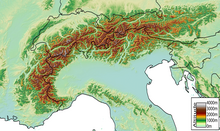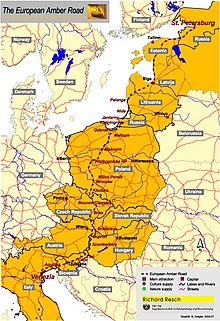





An alpine crossing or crossing of the Alps is a journey across the Alps of Europe, which usually runs transversely North-South (or more rarely also along the main chain of the Alps East-West). The Alps form a major "natural obstacle" across the European continent and crossing them has been a significant event throughout history for economic, military, and cultural reasons (including for religion and tourism). Consequently, crossings of the Alps have had significant impact for peoples, and ecology, of the region.
An Alpine crossing is usually referred to as a complete crossing of the mountain range of the Alps, such as from Munich to Venice or Basel to Milan, but also for routes that are still in the inner city, for example from Oberstdorf to Merano.
If the Main chain of the Alps is only crossed by a small area (for example from the Austrian town of Gries am Brenner to the neighbouring town of Brenner in Italy by crossing the Eisack Valley), it is not considered a full "Alpine crossing" but a crossing of the main chain.
The reasons for making 150-250km crossing of the "natural obstacle" between Central and Southern Europe, or Western and Eastern Europe, are diverse; including economic, military, political, religious, scientific, touristic and artistic.
Economic edit
Trade routes across the alps have been documented since the Bronze Age, and some finds confirm the exchange of goods between northern and southern Europe in the Neolithic period. Important connecting routes in pre-Roman times were the Col de Montgenèvre, the Great Saint Bernard pass, the Splügen Pass, the Reschen Pass and the Bernsteinstrasse from the Baltic Sea to the Adriatic Sea via the Julian Alps.
From the 12th century onwards, the "salt road", existing from pre-Roman times, gained importance as an trade route for north-south and west-east transit traffic. For example, salt was transported from Saline in the Rhône Valley to the metropolises of Northern Italy, and then onwards to Switzerland. The influence of small "pass states" states increased as a result of the increased traffic along these salt roads. For example, the Marquisate of Saluzzo built what is now the oldest tunnel in the Alps, the Monte Viso Tunnel, between 1475 and 1480.
Farming edit
Seasonally operated alpine pastures for livestock, often several hundred kilometres away from the winter quarters (known as transhumance), have been managed since the Bronze Age.
Military edit
Conquest edit
Military leaders have sometimes led their troops across the alps in order to reach a country they were intent on conquering. The two best known military leaders to attempt this were the Carthaginian general Hannibal, who famously took war elephants across the Pyrenees and alps in a bid to conquer Italy, and the French general Napoleon who also made a difficult alp crossing to try to conquer Italy.
Escape edit
Crossing the Alps has been a difficult necessity for people seeking refuge or escape from persecution or political upheaval such as the people like the Von Trapp family fleeing the Anschluss just before World War II. The memoir of Maria von Trapp was made first into a German film, then an American musical as well as an American film in which the crossing is an important scene, although fictional in detail. In reality, the family made the crossing not on foot as was shown, but travelled by train over the alps to Italy.[1]
Cultural edit
Religion edit
Pilgrimages for the purpose of visiting sites of religious significance have drawn Christians on journeys over the Alps. The first description of such an itinerary is found in the Itinerarium Burdigalense. It records the journey of an anonymous pilgrim from Bordeaux, written on the occasion of a visit to the Holy Land in the years 333-334. This route led over the remains of the Roman road network via Mont Cenis and Turin towards Rome.
Tourism edit
Crossing the Alps became an important component of journeys to Italy for the purposes of tourism in the 18th and 19th centuries. Until then the mountains had been "considered simply as nuisance: unproductive, obstacles to communication, the refuge of bandits and heretics."[2] As art historian Kenneth Clark wrote for his television series Civilisation:
"...the fact remains that when an ordinary traveller of the sixteenth and seventeenth centuries crossed the Alps it never occurred to him to admire the scenery - until the year 1739, when poet Thomas Gray, visiting the Grande Chartreuse, wrote in a letter: 'Not a precipice, not a torrent, not a cliff, but is pregnant with religion and poetry'."[2]
After this, two motivating forces drove many people across the alps. First, a reviving interest in classic art (especially that to be seen in Italy) and later, a developing interest in the natural environment as attitudes shifted from fear to awe under the influence of Romanticism. Many wealthy and educated northern Europeans crossed the alps to see Italian art and later more came to experience the mountain landscape as well.
Many of the well-known and influential writers and artists who made the crossing produced important works that referenced the journey and the experience. One of the most famous was early cultural tourists was Goethe. His Italian Journey, published in 1816-17, was based on the diaries of his trip from 1786-88, during which he crossed the Alps via the Brenner Pass. Goethe's Italian journey also resulted in a life-sized portrait of the author entitled Goethe in the Roman Campagna by Johann H.W. Tischbein, which the artist painted when Goethe was staying with him in Rome.[3] The painting, now held in Frankfurt's Städel Museum, depicts Goethe as "an exalted figure in the Italian landscape" and is regarded as a masterwork of "enduring impact".[3]
Another writer on whom the crossing made a powerful impression was John Ruskin. He went to Switzerland and thence to Venice in the 1830s, developed a love of the alps, returned annually, and published (among much else) his highly influential book Stones of Venice in the early 1850s.[4]
Contemporary tourists interested in seeing the landscape make the alps crossing by train. Three of the most popular routes are: the Gotthard Route, the Simplon Route and the Bernina Route.
Methods edit
On mule tracks, goods would be carried in a pack frame or back basket by humans, or transported by pack animals.
Driving, cycling, Planes....
References edit
- ^ Gearin, Joan (Winter 2005). "Movie vs. Reality: The Real Story of the von Trapp Family". National Archives. 37 (4). Retrieved 4 September 2017.
- ^ a b Clark, Kenneth (1969). Civilisation - A Personal View. London: Penguin Books. p. 190.
- ^ a b Schuck, Silke (2010). "Johann H.W. Tischbein" in European Masters - Städel Museum 19th-20th century. Petersburg: Michael Imhof Verlag. p. 30. ISBN 978-0-72410-320-1.
- ^ Wilmer, Clive (1985). Introduction to "Unto this Last and other writings". London: Penguin Books. p. 9.